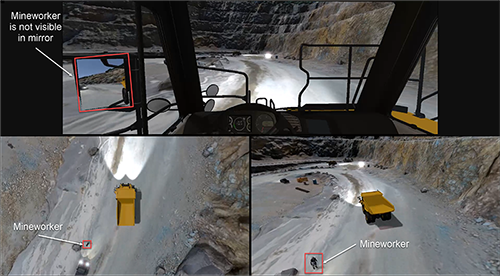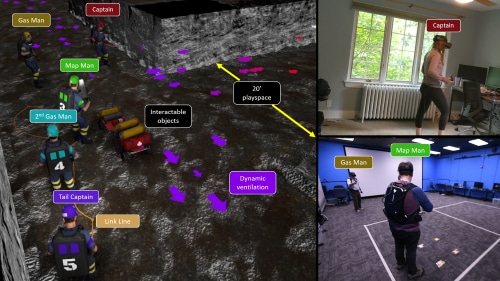Mining Project: Characterization of Haul Truck Health and Safety Issues
| Principal Investigator |
|
|---|---|
| Start Date | 1/25/2019 |
| End Date | 9/30/2023 |
| Objective |
To inform future health and safety research related to powered haulage by identifying and characterizing health and safety issues related to haul trucks through a systematic evaluation of accidents, operators’ needs, and technology maturity. |
Research Summary
Consistently, powered haulage accounts for the most fatalities in all mining. Fifty percent of the fatalities in 2017 (14 of 28) and 57% (4 of 7) of fatalities in the first few months of 2018 involved powered haulage [MSHA 2018b]. Mobile equipment accounts for most of these accidents. Mobile equipment was involved in nearly 40% (10) of the 28 overall fatalities and more than 30% of the overall injuries in 2017 [MSHA 2018c]. Of powered haulage and mobile equipment, haul trucks are the most prevalent piece of equipment. In fact, haul trucks account for over 45% of all equipment in the mining industry [PR Newswire 2015]. An estimated 44,500 haul trucks are in use worldwide [Parker Bay Company 2014]. In 2017, haul trucks were involved in six of the 28 fatalities [MSHA 2018a].
For the above reasons, haul trucks were selected as the subject for this research project and continue to be one of the leading health and safety concerns in mining. Haul trucks also share many similarities in design (e.g., operator cab, large size) and safety technology (e.g., collision avoidance systems, machine monitoring systems) with other pieces of mobile equipment such as bulldozers, front-end loaders, and service trucks. These similarities may allow for the generalization of the results to mobile equipment and powered haulage overall.
Research has shown that many of the accidents involving haul trucks appear to be related to operation and unidentified hazards, such as those hidden by blind spots [Porter 2016; Santos et al. 2010]. However, the underlying causes, what should be done, and where researchers’ efforts should be focused remain unclear. Therefore, the goals of this project were to better understand why these issues continue to occur and to identify any research and technology gaps that currently exist. This project used a mixed-methods approach and a situational awareness-oriented design framework.
The six research tasks for this project were as follows:
(1) Industry Engagement: Visited and held discussions with mine operators, manufacturers, industry associations, and other stakeholders to determine what the current state of the industry was and identified stakeholder concerns.
(2) Accident Analyses: Analyzed human-machine interface failures that may have contributed to the occurrence or severity of a fatality involving a haul truck.
(3) Cognitive Task Analysis: Explored how various workers perceived haul truck hazards, skills and expertise, training, and how operators responded to challenging or nonroutine scenarios related to human-machine interface failures identified in Task 1.
(4) Technology Readiness Assessment: Assessed the maturity of collisions warning and avoidance technologies related to human-machine interface failures identified in Task 1.
(5) Training Materials: Developed haul truck simulated accident recreations based on the narratives captured in Task 3 that are targeted for mineworker training.
(6) VR Training: Designed and developed a multi-player virtual reality (VR) training application. To leverage previous work, this task targeted mine rescue teams and assessed usability and acceptance at mine rescue competitions in collaboration with the Mine Safety and Health Administration (MSHA).
This project laid the groundwork for additional research by identifying and characterizing health and safety issues related to haul trucks. The results of this work have identified research, technology, and implementation gaps related to haul truck operation. The findings were summarized in NIOSH's Haul Truck Research Roadmap Report 2020. The results of this work are also actively being used to conduct additional research to address the gaps identified.
Finally, this project also created a proof-of-concept application for virtual reality (VR) training, referred to as VR Mine Rescue Training (VR-MRT). The usability and acceptability of this application was very high and is being fully evaluated for effectiveness, adoption, and implementation in a follow-on project, Evaluation of VR Mine Rescue Training Platform.
Outputs
Hoebbel C, Bellanca JL, Hrica JK [2024]. Lessons learned from haul truck operator near-miss events: Use of the critical decision method to identify strategies to improve operator safety in mining. Tucson AZ: Society for Mining, Metallurgy & Exploration Annual Conference & Expo.
Bellanca JL, Orr TJ, Hoebbel C, Helfrich W, Macdonald B, Navoyski J, Demich B, Mechling JJ, Schmidt PE, Chasko LL, Cohen J. [2023]. Usability of collaborative “VR Mine Rescue Training” platform. In: APCOM 2023, Intelligent Mining: Innovation, Vision, and Value. Rapid City, SD.
Bellanca JL, Macdonald B, Navoyski J, Hrica JK, Orr TJ Demich B, Hoebbel CL [2023]. Using near-miss events to create training videos. Min Metal Expl 40:1091–1099.
Hrica JK, Bellanca JL, Benbourenane IL, Carr JL, Homer JP [2022]. A rapid review of collision avoidance and warning technologies for haul trucks. Min Metal Expl 39:1357–1389.
Hrica JK, Bellanca JL, Benbourenane IL, Orr TJ [2022]. Use of cognitive task analysis to inform future research and identify solutions for haul truck safety. Salt Lake City, UT: Society for Mining, Metallurgy & Exploration Annual Conference & Expo.
Bellanca JL, Ryan ME, Orr TJ, Burgess-Limerick RJ [2021]. Why do haul truck fatal accidents keep occurring? Min Metal Expl 38:1019–1029.
NIOSH [2020]. Haul truck research roadmap report 2020. Pittsburgh, PA: U.S. Department of Health and Human Services, Centers for Disease Control and Prevention, National Institute for Occupational Safety and Health.
References
Mine Safety and Health Administration [2018a]. Fatality reports. Accessed 22 February 2018.
Mine Safety and Health Administration [2018b]. Quarterly stakeholder call. 30 April 2018.
Mine Safety and Health Administration [2018c]. Safety improvement technologies for mobile equipment at surface mines, and for belt conveyors at surface and underground mines, vol. 83, 2018, p. 29716.
Porter W [2016]. Haul trucks can kill! Coal Zoom. October 18.
PR Newswire [2015]. Global mining truck market 2015-2019 - growth of mining truck rental business with Caterpillar, Hitachi Construction Machinery & Komatsu dominating. Cision, 7 October 2015.
Santos B, Porter W, Mayton A [2010]. An analysis of injuries to haul truck operators in the U.S. mining industry. In Proceedings of the Human Factors and Ergonomics Society Annual Meeting, Los Angeles, CA.
The Parker Bay Company [2014]. Mining trucks. Accessed 22 February 2018.
- An Analysis of Injuries to Haul Truck Operators in the U.S. Mining Industry
- Engineering Considerations and Selection Criteria for Proximity Warning Systems for Mining Operations
- Haul Truck Research Roadmap Report 2020
- Haul Trucks Can Kill!
- Monitoring Blind Spots: A Major Concern for Haul Trucks
- Patterns in Mining Haul Truck Accidents
- Powered Haulage Safety Initiative
- Preventing Equipment Related Injuries in Underground U.S. Coal Mines
- Proximity Detection
- Recommendations for Evaluating & Implementing Proximity Warning Systems on Surface Mining Equipment
- Task Analysis
- Test Results of Collision Warning Systems for Surface Mining Dump Trucks
- Tying Acceleration and GPS Location Information Together To Create a Mine Management Tool

